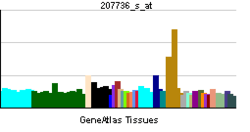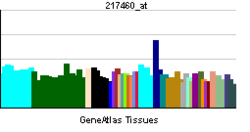TNP2
Nuclear transition protein 2 is a protein that in humans is encoded by the TNP2 gene.[1][2][3]
References
Further reading
- Schlüter G, Kremling H, Engel W (1992). "The gene for human transition protein 2: nucleotide sequence, assignment to the protamine gene cluster, and evidence for its low expression.". Genomics 14 (2): 377–83. doi:10.1016/S0888-7543(05)80229-0. PMID 1385303.
- Kundu TK, Rao MR (1995). "DNA condensation by the rat spermatidal protein TP2 shows GC-rich sequence preference and is zinc dependent.". Biochemistry 34 (15): 5143–50. doi:10.1021/bi00015a027. PMID 7711033.
- Nelson JE, Krawetz SA (1995). "Characterization of a human locus in transition.". J. Biol. Chem. 269 (49): 31067–73. PMID 7983046.
- Nelson JE, Krawetz SA (1993). "Linkage of human spermatid-specific basic nuclear protein genes. Definition and evolution of the P1-->P2-->TP2 locus.". J. Biol. Chem. 268 (4): 2932–6. PMID 8428967.
- Kundu TK, Rao MR (1997). "Zinc dependent recognition of a human CpG island sequence by the mammalian spermatidal protein TP2.". Biochemistry 35 (49): 15626–32. doi:10.1021/bi961271i. PMID 8961924.
- Steger K; Klonisch T; Gavenis K et al. (1999). "Expression of mRNA and protein of nucleoproteins during human spermiogenesis". Mol. Hum. Reprod. 4 (10): 939–45. doi:10.1093/molehr/4.10.939. PMID 9809674.
- Wyckoff GJ, Wang W, Wu CI (2000). "Rapid evolution of male reproductive genes in the descent of man". Nature 403 (6767): 304–9. doi:10.1038/35002070. PMID 10659848.
- Strausberg RL; Feingold EA; Grouse LH et al. (2003). "Generation and initial analysis of more than 15,000 full-length human and mouse cDNA sequences". Proc. Natl. Acad. Sci. U.S.A. 99 (26): 16899–903. doi:10.1073/pnas.242603899. PMC 139241. PMID 12477932.
- Wykes SM, Krawetz SA (2003). "The structural organization of sperm chromatin". J. Biol. Chem. 278 (32): 29471–7. doi:10.1074/jbc.M304545200. PMID 12775710.
- Miyagawa Y; Nishimura H; Tsujimura A et al. (2006). "Single-nucleotide polymorphisms and mutation analyses of the TNP1 and TNP2 genes of fertile and infertile human male populations". J. Androl. 26 (6): 779–86. doi:10.2164/jandrol.05069. PMID 16291974.
- Jedrzejczak P; Kempisty B; Bryja A et al. (2007). "Quantitative assessment of transition proteins 1, 2 spermatid-specific linker histone H1-like protein transcripts in spermatozoa from normozoospermic and asthenozoospermic men". Arch. Androl. 53 (4): 199–205. doi:10.1080/01485010701426430. PMID 17852044.
|
|---|
| Envelope (membrane)/
nuclear lamina | |
|---|
| | Nucleolus | |
|---|
| | Other | |
|---|
| see also nucleus diseases
Index of cells |
|---|
| | Description |
- Structure
- Organelles
- peroxisome
- cytoskeleton
- centrosome
- epithelia
- cilia
- mitochondria
- Membranes
- Membrane transport
- ion channels
- vesicular transport
- solute carrier
- ABC transporters
- ATPase
- oxidoreduction-driven
|
|---|
| | Disease |
- Structural
- peroxisome
- cytoskeleton
- cilia
- mitochondria
- nucleus
- scleroprotein
- Membrane
- channelopathy
- solute carrier
- ATPase
- ABC transporters
- other
- extracellular ligands
- cell surface receptors
- intracellular signalling
- Vesicular transport
- Pore-forming toxins
|
|---|
|
|

